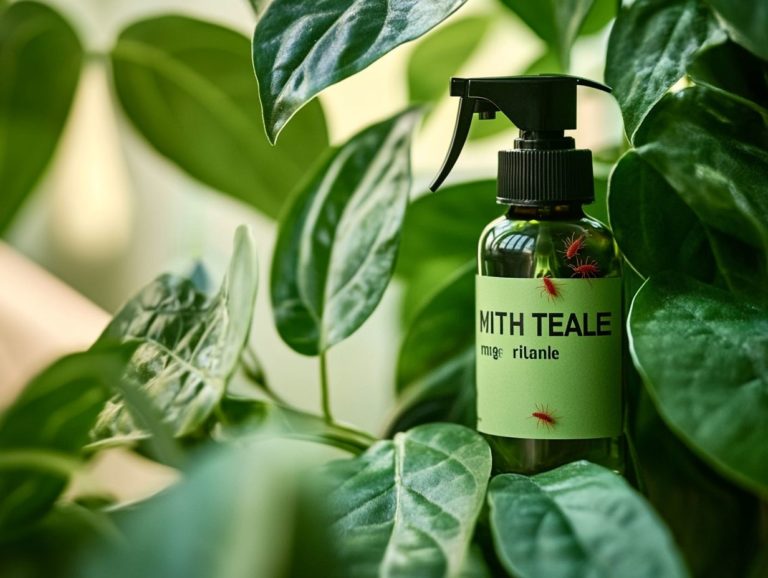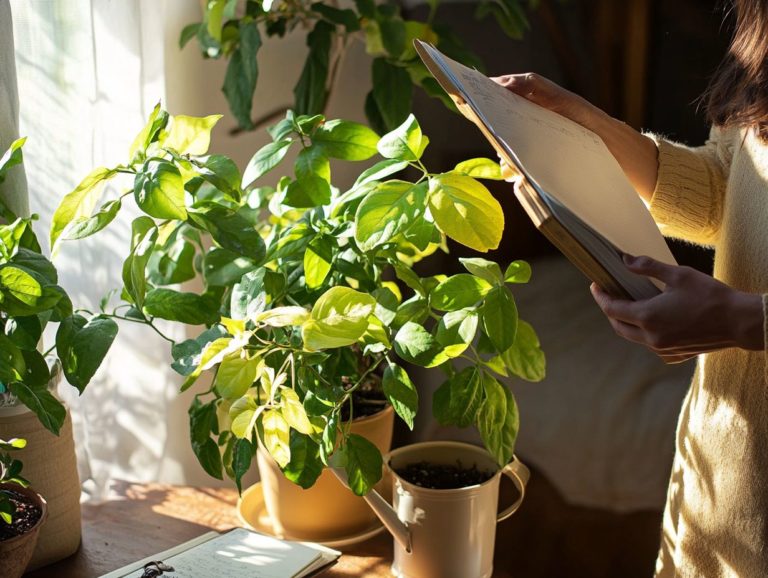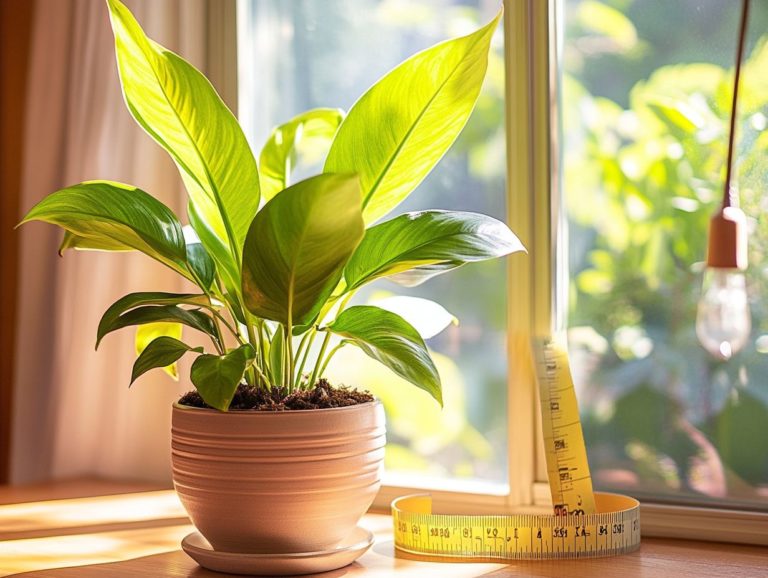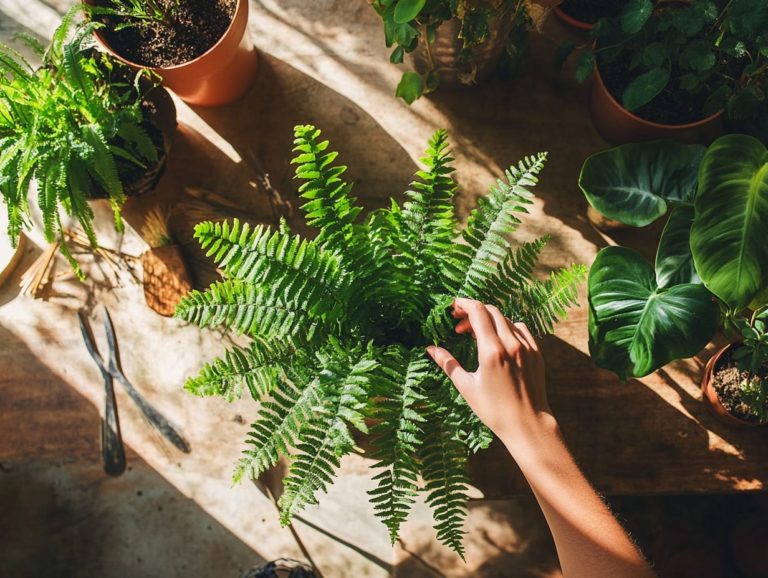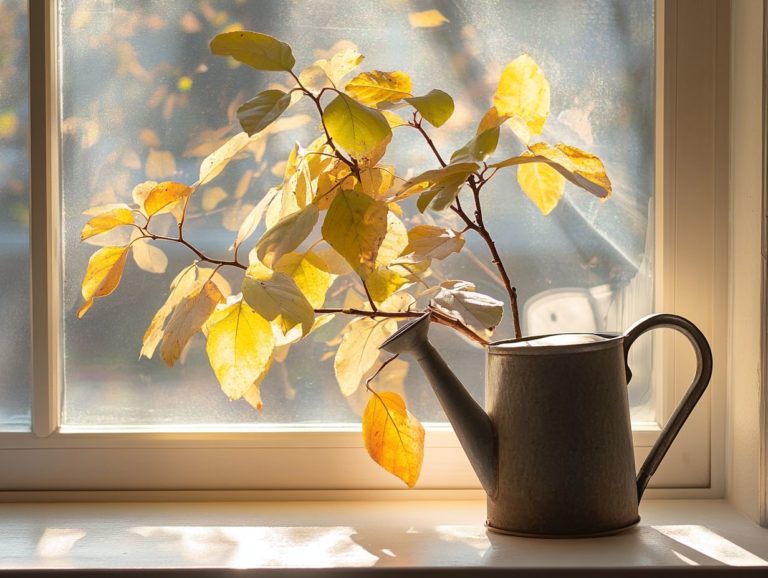Understanding Leaf Spots in Indoor Plants
Leaf spots in your indoor plants can be a frustrating puzzle for plant lovers eager to keep their plants healthy! These unsightly blemishes often indicate underlying issues that could jeopardize the health of your beloved plants.
This article delves into what leaf spots are, exploring the various types including fungal, bacterial, and viral and guiding you on how to identify their unique signs. You ll also discover effective treatment methods and preventive care strategies designed to keep your plants thriving.
Whether you re just starting out or you ve been cultivating plants for years, grasping the nuances of leaf spots is crucial for preserving the beauty and vitality of your indoor oasis.
Contents
Key Takeaways:
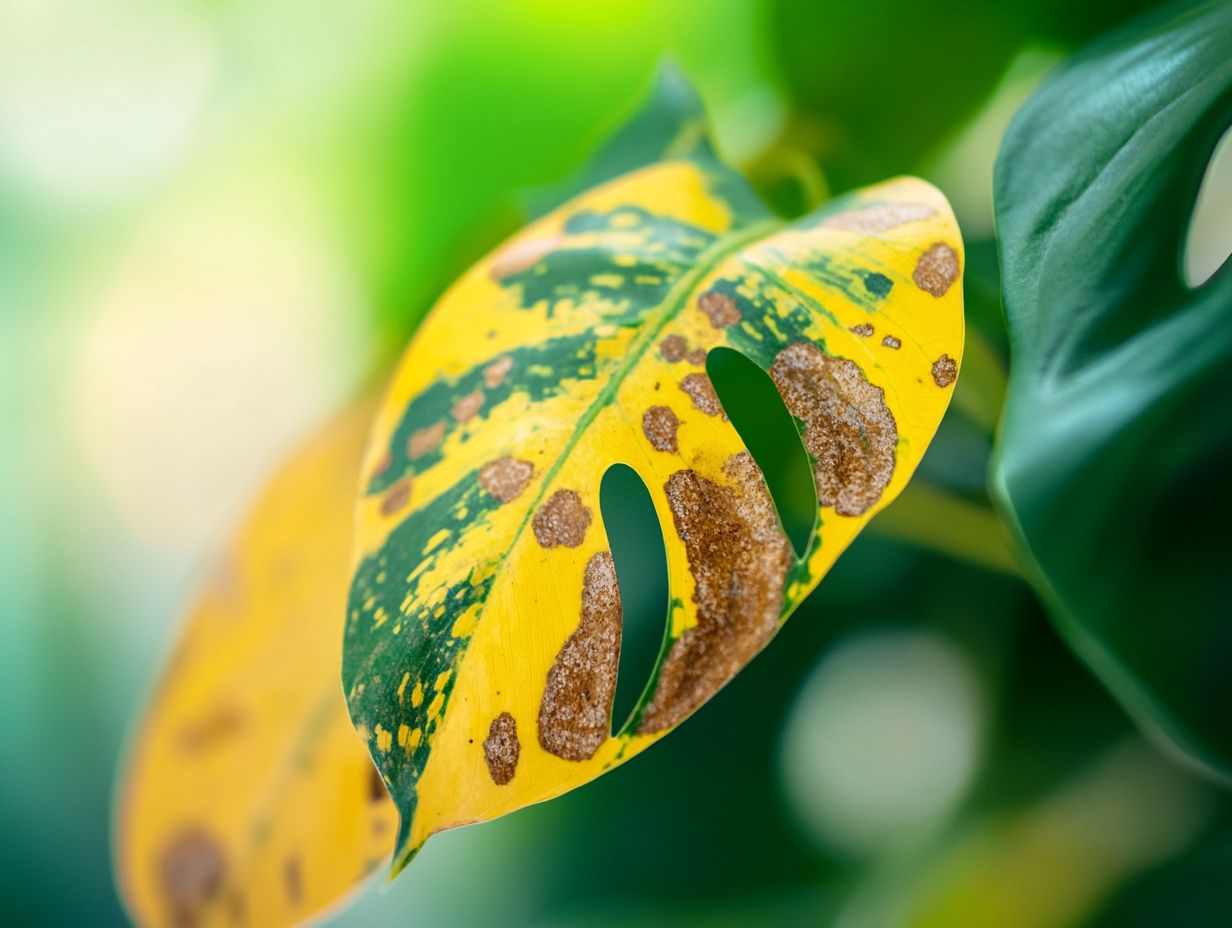
- Understanding the different types of leaf spots (fungal, bacterial, and viral) helps you identify and treat them effectively.
- Proper plant care and maintenance, along with preventive measures, can help prevent leaf spots in indoor plants.
- Identifying signs and symptoms of leaf spots early on and using effective treatment methods can save your indoor plants from further damage.
Overview of Leaf Spots in Indoor Plants
Understanding leaf spots in your indoor plants is crucial for maintaining their health, as these unsightly marks can signal various underlying problems. Whether it s leaf damage from environmental stressors, nutrient deficiencies, or pest problems (such as Aphids, Whitefly, and Mealybug), identifying the cause is key.
Leaf spots typically fall into three main categories: fungal, bacterial, and viral diseases, each with its own distinct symptoms and treatment approaches. Additionally, understanding what causes leaf drop in indoor plants can help you manage their health effectively. By catching these issues early, you can take the necessary steps to keep your plants vibrant and resilient, ultimately enriching your gardening experience with a flourishing collection of houseplants.
What are Leaf Spots?
Leaf spots are those unsightly discolored patches that can appear on your houseplant leaves. They can arise from a variety of factors, including growing conditions and environmental stressors.
These spots often signal underlying issues, such as improper watering, incorrect light, or excessive humidity, which can cause leaf discoloration. All of these factors can inflict serious damage on your plant’s leaves. For example, if you ve been keeping your plant in overly moist soil, it may fall prey to fungal infections, which are diseases caused by harmful fungi. This can lead to leaf deformation, showing up as unsightly brown or yellow spots. Inconsistent watering practices stress your plant, making it more vulnerable to pests and diseases.
Understanding these causes is essential for anyone passionate about houseplants who wants to keep their foliage looking vibrant and healthy. After all, unchecked leaf spots can seriously compromise both the health and aesthetic appeal of your green companions.
Types of Leaf Spots
Leaf spots can be classified into three main types: fungal leaf spots, bacterial leaf spots, and viral leaf spots. Each type showcases unique symptoms, such as brown leaves, and necessitates specific treatment strategies for effective management, including the use of Daconil Fungicide and Neem oil.
Knowing these differences helps you care for your plants effectively.
Fungal Leaf Spots
Fungal leaf spots frequently plague houseplants, often emerging from various fungal diseases that thrive in humid environments.
If left unaddressed, these unsightly patches can cause significant damage. You ll likely notice discolored spots that may range from yellow to brown, indicating issues like moisture retention or temperature fluctuations. In more severe cases, the leaves might curl or drop prematurely.
Common culprits behind these fungal infections include overcrowding of plants, poor air circulation, and an excess of moisture. To tackle these challenges effectively, selecting appropriate treatments is essential.
Products like Daconil Fungicide create a protective barrier against these pesky pathogens, while Neem oil works systemically to disrupt their growth cycle. By gaining a solid understanding of and adhering to proper care guidelines, you can significantly reduce the risk of these infections and keep your plants thriving.
Bacterial Leaf Spots
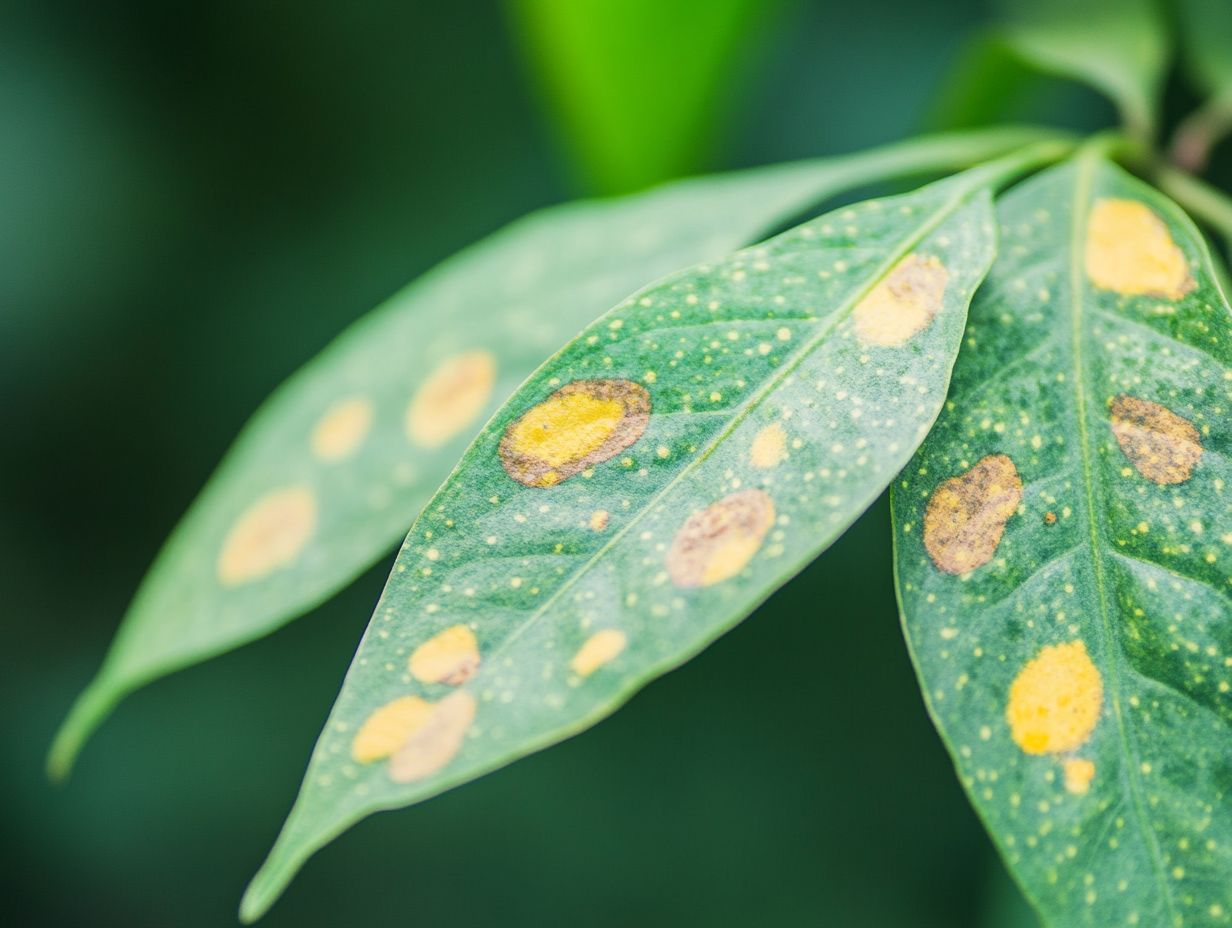
Bacterial leaf spots are a common concern for houseplant enthusiasts like you. They are marked by pesky water-soaked lesions that seem to multiply rapidly in moist conditions.
These unattractive spots often indicate a deeper issue that worsens with high humidity and insufficient air circulation. You may notice yellowing leaves and brown tips. As those lesions expand, your plant may start dropping leaves prematurely, compromising its overall health.
The culprits behind these spots are typically infections from bacteria such as *Xanthomonas* or *Pseudomonas*. They flourish in damp environments. Pest infestations, like aphids and spider mites, can also stress your plants, making them more vulnerable to these bacterial invaders.
To tackle this problem, enhance air circulation and refine your watering techniques. You might also consider repotting plants to alleviate the effects of physical damage. In more severe cases, reach for fungicides specifically formulated to combat bacterial diseases.
Viral Leaf Spots
Viral leaf spots appear as unsightly patterns of discoloration on your leaves. They can significantly undermine the growth and vitality of your houseplants.
These blemishes, often the result of viral infections, not only detract from the visual appeal of your plants but also signal deeper issues like nutrient deficiencies.
If your plants are lacking in iron or magnesium, symptoms can worsen, leading to stunted growth. This makes them more vulnerable to additional infections.
As the health of your plants deteriorates, their ability to photosynthesize effectively becomes compromised. Ultimately, this impacts their vigor and resilience.
The spread of viral pathogens can pose a serious challenge for both hobbyists and professional growers alike.
Identifying and Treating Leaf Spots
Spotting and treating leaf spots quickly keeps your plants healthy and thriving! Early detection allows you to effectively mitigate the impact of various diseases.
Signs and Symptoms
Common signs of leaf spots in your houseplants include yellowing leaves, brown tips, and distinctive discoloration patterns.
You might notice dark brown or black spots that could spread or enlarge over time. These could ultimately damage more foliage.
In some instances, these spots may be accompanied by watery lesions, hinting at a potential fungal infection. This is especially true in humid conditions or areas with poor air circulation.
Your affected plants may also show overall distress, such as stunted growth or drooping leaves. This could point to issues like overwatering or nutrient deficiencies.
By keenly observing these symptoms, you can diagnose problems early. This creates an opportunity for effective treatment and recovery.
Effective Treatment Methods
Act fast! Identifying the cause of leaf spots is key to saving your plants. Effective treatment methods hinge on accurately identifying whether it s a fungal, bacterial, or viral disease.
Once you ve pinpointed the specific type, you can implement various treatment strategies. For example, if you re dealing with fungal leaf spots, enhance air circulation and reduce humidity by careful spacing and pruning.
Chemical treatments, like fungicides, can also be effective when paired with these cultural practices.
If you encounter bacterial leaf spots, swiftly remove infected leaves to prevent further spread. Consider using OMRI-listed Alaska Fish Fertilizer for better plant nutrition.
Copper-based sprays are often recommended as a preventative measure. For viral leaf spots, focus on controlling pest populations that transmit these viruses. Ensure that healthy plants take precedence in your care routines.
Preventing Leaf Spots

Preventing leaf spots in houseplants is crucial for maintaining their health. You can achieve this through attentive plant care and a keen understanding of the specific cultural conditions that best support their growth.
Proper Plant Care and Maintenance
Proper plant care and maintenance are essential in preventing leaf spots. They ensure your houseplants thrive free from issues related to moisture retention or nutrient imbalances that could lead to leaf damage.
To cultivate vibrant, healthy plants, it s vital to establish a consistent watering schedule that caters to the specific needs of each species. Overwatering can lead to root rot, while underwatering may result in wilting and stress.
Repotting becomes essential when your plants outgrow their containers. This allows for improved soil quality and root development. Regularly checking humidity levels and light exposure can further enhance growth, making it imperative to monitor those environmental conditions.
By sticking to these simple plant care practices, you can create the ideal atmosphere for your indoor greenery to truly flourish.
Preventive Measures and Tips
Implementing preventive measures can significantly reduce the occurrence of leaf spots in your houseplants. This leads to a healthier gardening experience.
By adopting a proactive approach, you can ensure your plants thrive while minimizing the risk of infections from fungus or pests. Check your plants regularly for any unusual spots or pests to catch issues early.
Utilizing effective pest management techniques, like introducing beneficial insects such as ladybugs, can naturally keep pest populations down, helping to prevent leaf spots.
Maintaining proper air circulation around your plants and avoiding overcrowding will also deter moisture buildup. This creates an environment less conducive to disease.
Fertilizing appropriately and avoiding overhead watering are crucial steps to prevent waterlogging on leaves. This ensures your plants remain healthy and vibrant.
Frequently Asked Questions
What are leaf spots in indoor plants?
Leaf spots are small, discolored areas on the leaves of indoor plants. They can range in color from brown or black to yellow or red, and can occur on the top or bottom of the leaf.
What causes leaf spots in indoor plants?

Leaf spots usually happen because of fungus or bacteria. They can also result from environmental factors like overwatering, poor air circulation, or nutrient deficiencies. Additionally, they might indicate the presence of pests or diseases.
How can I prevent leaf spots in indoor plants?
To prevent leaf spots, maintain a clean and healthy environment for your plants. This includes regularly wiping down leaves, avoiding overwatering, and providing proper air circulation.
It’s also important to inspect your plants regularly for signs of pests or diseases.
Can leaf spots be treated?
Yes, leaf spots can be treated. If caught early, simply removing the affected leaves and improving the plant’s growing conditions may be enough to eliminate the spots.
More severe cases may require the use of fungicides or other treatments. It’s essential to identify the cause of the spots before attempting any treatment.
Are leaf spots harmful to my indoor plants?
In most cases, leaf spots do not pose a serious threat to the overall health of indoor plants. However, if left untreated, they can spread and result in significant damage. Address leaf spots immediately to prevent further damage!
Can I still eat fruits or vegetables from plants with leaf spots?
If your indoor plant is a fruit or vegetable-producing plant and has leaf spots, it’s best to avoid eating any harvested produce from it. While the leaf spots may not directly harm humans, they could indicate harmful bacteria or fungi that might make you sick if ingested.
It’s better to err on the side of caution and dispose of any affected fruits or vegetables.
Have questions about your plants? Share them in the comments below!

